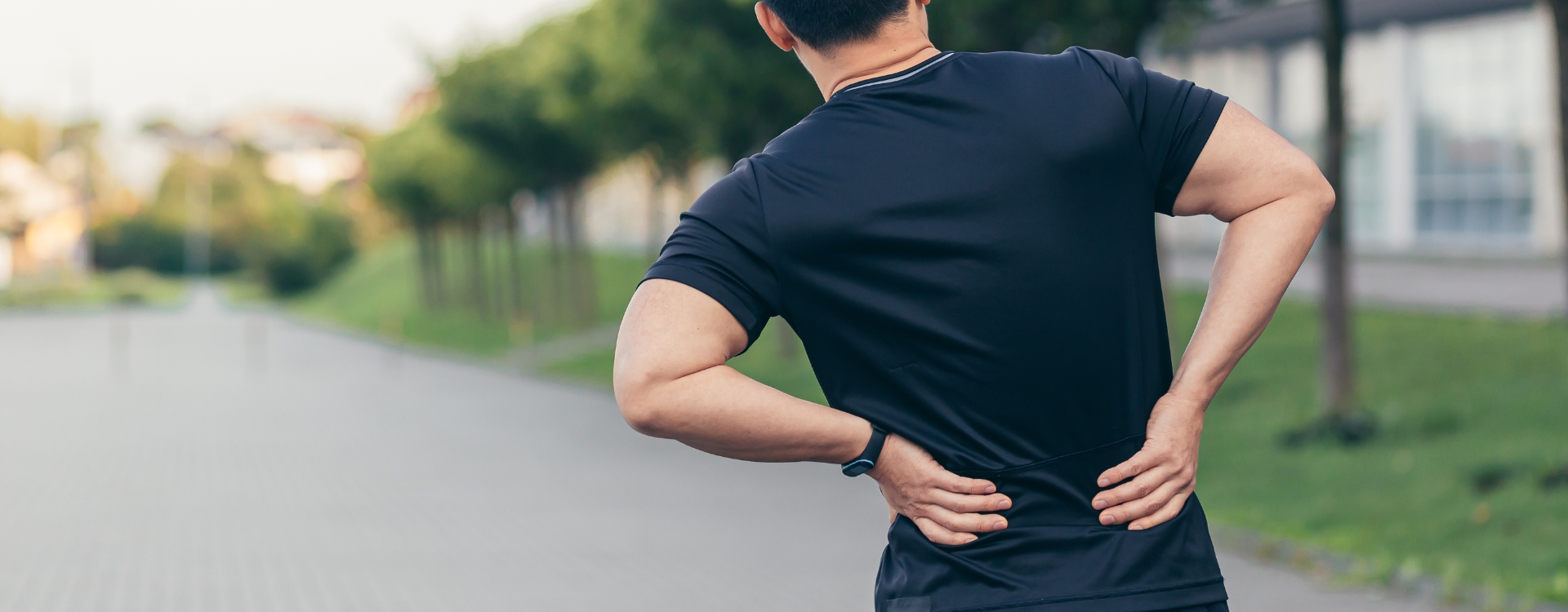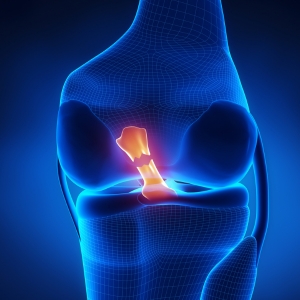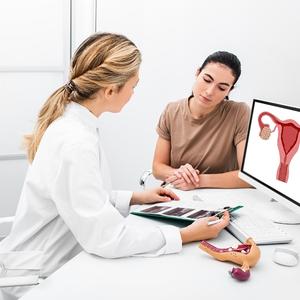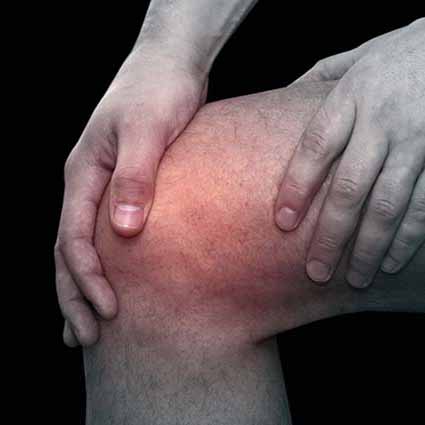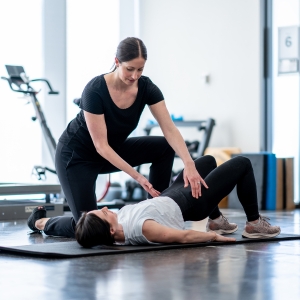Low back pain is one of the most common health issues faced by people today. It affects an estimated 8 out of 10 adults at some point in their lives, and for many it can be a recurring problem. It is most prevalent in people between 40 to 60 years of age. Fortunately, lower back pain can usually be treated with a combination of lifestyle changes and medications and most people recover within six weeks.
The low back, also called the lumbar region, is the area of the back that starts below the ribcage. It consists of 5 five lumbar vertebrae (bones) that connect your upper spine to your pelvis.

Signs and symptoms
Common low back pain symptoms include stiffness, soreness, difficulty in moving or walking, and dull aches in the lower back region. The pain can radiate to the buttocks and legs causing numbness or tingling sensations, a phenomenon called sciatica.

Common causes of low back pain
Low back pain can be defined into two major types, acute and chronic. There are various causes of low back pain which affect different spinal structures, in this article we will explore these.

ACUTE LOW BACK PAIN
Common causes include injury, accident or poor manual handling skills.
- Strained Muscle
Back muscles are overloaded or overstretched by lifting heavy objects or by an unexpected twisting force. - Strained Ligament
Sudden movements, such as a fall or poor lifting technique can cause strained ligaments as the muscles may not have enough time to contract properly to protect the spine, causing ligaments to overstretch or tear. - Slipped Disc
The jelly-like intervertebral disc can be squeezed out by sudden heavy lifting or twisting. This puts pressure on the spinal cord, compressing the nerve roots and causes symptoms of back pain.

CHRONIC LOW BACK PAIN
Chronic low back pain is most commonly associated with degeneration due to ageing or prolonged poor posture.
- Discogenic pain / Herniated disc
The jelly-like intervertebral disc can be squeezed out by prolonged poor posture. This puts pressure on the spinal cord, compressing the nerve roots which causes pain. - Lumbar Spondylosis
The spine degenerates due to ageing or prolonged poor posture. The intervertebral disc space becomes narrow and the soft tissues surrounding the facet joints are thickened and calcified, forming bone spurs which may compress the spinal nerves and cause symptoms of back pain. - Spondylolisthesis
When one vertebra slips forward onto the adjacent vertebrae, this results in both a gradual deformity of the lumbar spine and a narrowing of the vertebral canal. It can also be caused by degeneration of the spine, poor posture or a congenital defect. - Spinal Stenosis
Lumbar spinal stenosis is a narrowing of the spinal canal, compressing the nerves travelling through the lower back into the legs. While it may affect younger people, due to developmental causes, it is more often a degenerative condition that affects people who are typically aged 60 and older.
Narrowing of the spinal canal usually occurs slowly, over many years. The discs become less spongy with ageing, resulting in the loss of disc height, and may cause bulging of the hardened disc into the spinal canal. Bone spurs may also be formed and ligaments may become thickened. All of these can contribute to the narrowing of the central canal and may or may not produce symptoms.
Symptoms may be due to inflammation, compression of the nerves or both. This may cause trouble when walking distances and you may find that you need to lean forward to relieve pressure on the lower back. There may also be pain or numbness in the legs. In more severe cases, this may lead to difficulty in controlling the bowel and bladder.
OTHER FACTORS:
Other factors include obesity, stress, osteoporosis and cancers.

What can I do if I have low back pain?
- Rest
The first step in the treatment of low back pain is to let the spine rest. This reduces the muscle spasm and helps the healing process. Avoid lifting, twisting and physical exertion. - Ice or Heat
An ice pack is usually used soon after an acute injury such as back strain. After that, applications of heat packs can help ease much of the discomfort associated with the muscle spasm causing the low back pain. Use either of these regularly for 15 minutes each time.

Warning Signs
Most episodes of back pain last for a few days and are completely resolved within a few weeks. However, there are also a few warning signs that may indicate the need for immediate medical attention:
- back pain that persists beyond a few days that wakes you at night
- constant numbness and increasing weakness in the legs
- difficulty in controlling the bowel or bladder
- numbness around the genital region
- fever, chills, sweats or other signs of infection

Treatment options
- Medication
The doctor will prescribe different medications to control the pain at an early stage. Anti-inflammatory medications are helpful in reducing back pain and the associated inflammation. The doctor may also prescribe painkillers or muscle relaxants to further control pain and muscle spasm. If other medical conditions, such as a stomach problem, are present, please consult the doctor or pharmacist for advice. - Physiotherapy
The doctor may refer a patient with low back pain to a physiotherapist, who will assess the condition and deliver appropriate treatments, such as manual therapy, soft tissue massage and electrotherapy to reduce the pain and improve tissue healing. They will also advise on postural correction, back care and proper lifting techniques.
Appropriate exercise is also important to improve muscle function in the later stage of rehabilitation. Pilates is one of the commonly used approaches to improve core muscle control through muscle training, and to facilitate a correct posture and movement pattern to prevent re-injury. - Surgical intervention
If the condition does not settle with medication and physiotherapy treatment, a specialist may suggest some diagnostic tests, for example, X-rays, MRI scan and discography. Decompression and stabilisation surgery may also be advised should the response to conservative treatment be unsatisfactory. Most spinal surgeries can be done through minimally invasive techniques. Please discuss with the specialist for the surgical options. - Prevention
Taking steps to prevent low back pain is important – including regular exercise, maintaining good posture, using proper lifting techniques, and taking frequent breaks while sitting or standing can help reduce the chances of lower back pain developing.
By following a combination of prevention strategies and treatment options, lower back pain can be managed successfully. If you are experiencing lower back pain, it is important to talk to your doctor so you can find the best solution for your needs.
Call us at 2537 7702 if you wish to arrange an appointment with an orthopedi specialist focussed, or click the below link to book online:
Articles on this website are informative only and not intended to be a substitute for professional medical advice, diagnosis or treatment. They should not be relied upon for specific medical advice.

Information provided by:
Physiotherapy Department, Matilda International Hospital
